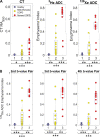Emphysema Index Based on Hyperpolarized 3He or 129Xe Diffusion MRI: Performance and Comparison with Quantitative CT and Pulmonary Function Tests
- PMID: 32779976
- PMCID: PMC7526952
- DOI: 10.1148/radiol.2020192804
Emphysema Index Based on Hyperpolarized 3He or 129Xe Diffusion MRI: Performance and Comparison with Quantitative CT and Pulmonary Function Tests
Abstract
Background Apparent diffusion coefficient (ADC) maps of inhaled hyperpolarized gases have shown promise in the characterization of emphysema in patients with chronic obstructive pulmonary disease (COPD), yet an easily interpreted quantitative metric beyond mean and standard deviation has not been established. Purpose To introduce a quantitative framework with which to characterize emphysema burden based on hyperpolarized helium 3 (3He) and xenon 129 (129Xe) ADC maps and compare its diagnostic performance with CT-based emphysema metrics and pulmonary function tests (PFTs). Materials and Methods Twenty-seven patients with mild, moderate, or severe COPD and 13 age-matched healthy control subjects participated in this retrospective study. Participants underwent CT and multiple b value diffusion-weighted 3He and 129Xe MRI examinations and standard PFTs between August 2014 and November 2017. ADC-based emphysema index was computed separately for each gas and b value as the fraction of lung voxels with ADC values greater than in the healthy group 99th percentile. The resulting values were compared with quantitative CT results (relative lung area <-950 HU) as the reference standard. Diagnostic performance metrics included area under the receiver operating characteristic curve (AUC). Spearman rank correlations and Wilcoxon rank sum tests were performed between ADC-, CT-, and PFT-based metrics, and intraclass correlation was performed between repeated measurements. Results Thirty-six participants were evaluated (mean age, 60 years ± 6 [standard deviation]; 20 women). ADC-based emphysema index was highly repeatable (intraclass correlation coefficient > 0.99) and strongly correlated with quantitative CT (r = 0.86, P < .001 for 3He; r = 0.85, P < .001 for 129Xe) with high AUC (≥0.93; 95% confidence interval [CI]: 0.85, 1.00). ADC emphysema indices were also correlated with percentage of predicted diffusing capacity of lung for carbon monoxide (r = -0.81, P < .001 for 3He; r = -0.80, P < .001 for 129Xe) and percentage of predicted residual lung volume divided by total lung capacity (r = 0.65, P < .001 for 3He; r = 0.61, P < .001 for 129Xe). Conclusion Emphysema index based on hyperpolarized helium 3 or xenon 129 diffusion MRI provides a repeatable measure of emphysema burden, independent of gas or b value, with similar diagnostic performance as quantitative CT or pulmonary function metrics. © RSNA, 2020 Online supplemental material is available for this article. See also the editorial by Schiebler and Fain in this issue.
Figures







Comment in
-
Hyperpolarized Noble Gas Ventilation MRI in COPD.Radiology. 2020 Oct;297(1):211-213. doi: 10.1148/radiol.2020202855. Epub 2020 Aug 11. Radiology. 2020. PMID: 32804051
References
-
- Global Initiative for Chronic Obstructive Lung Disease (GOLD) . Global Strategy for the Diagnosis, Management and Prevention of COPD. https://goldcopd.org/. Published 2019. Accessed December 12, 2019. - PubMed
-
- Müller NL, Staples CA, Miller RR, Abboud RT. “Density mask”. An objective method to quantitate emphysema using computed tomography. Chest 1988;94(4):782–787. - PubMed
-
- Gierada DS, Yusen RD, Pilgram TK, et al. . Repeatability of quantitative CT indexes of emphysema in patients evaluated for lung volume reduction surgery. Radiology 2001;220(2):448–454. - PubMed
-
- Madani A, Van Muylem A, Gevenois PA. Pulmonary emphysema: effect of lung volume on objective quantification at thin-section CT. Radiology 2010;257(1):260–268. - PubMed
Publication types
MeSH terms
Substances
Grants and funding
LinkOut - more resources
Full Text Sources
Medical

